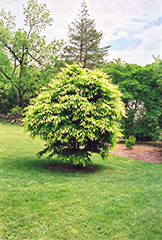Fri & Sat 8am - 8pm
Sun 8am - 7pm
Anytown, USA 12345
fax: 261.787.0463
e-mail: info@successgc.com


Plant Finder

Height: 20 feet
Spread: 20 feet
Sunlight:
![]()
![]()
![]()
Hardiness Zone: 5b
Description:
A rare but special small tree with leaves that look more like a hornbeam than a maple; beautiful shape when mature, quite dense, and good fall color; an excellent showpiece plant for the collector
Ornamental Features
Hornbeam Maple has dark green deciduous foliage on a tree with an upright spreading habit of growth. The pointy leaves turn outstanding shades of yellow and gold in the fall.
Landscape Attributes
Hornbeam Maple is a dense multi-stemmed deciduous tree with an upright spreading habit of growth. Its average texture blends into the landscape, but can be balanced by one or two finer or coarser trees or shrubs for an effective composition.
This is a relatively low maintenance tree, and usually looks its best without pruning, although it will tolerate pruning. It has no significant negative characteristics.
Hornbeam Maple is recommended for the following landscape applications;
- Accent
- Hedges/Screening
Planting & Growing
Hornbeam Maple will grow to be about 20 feet tall at maturity, with a spread of 20 feet. It has a low canopy with a typical clearance of 3 feet from the ground, and is suitable for planting under power lines. It grows at a slow rate, and under ideal conditions can be expected to live for 70 years or more.
This tree performs well in both full sun and full shade. It prefers to grow in average to moist conditions, and shouldn't be allowed to dry out. It is not particular as to soil type or pH. It is quite intolerant of urban pollution, therefore inner city or urban streetside plantings are best avoided, and will benefit from being planted in a relatively sheltered location. This species is not originally from North America.
